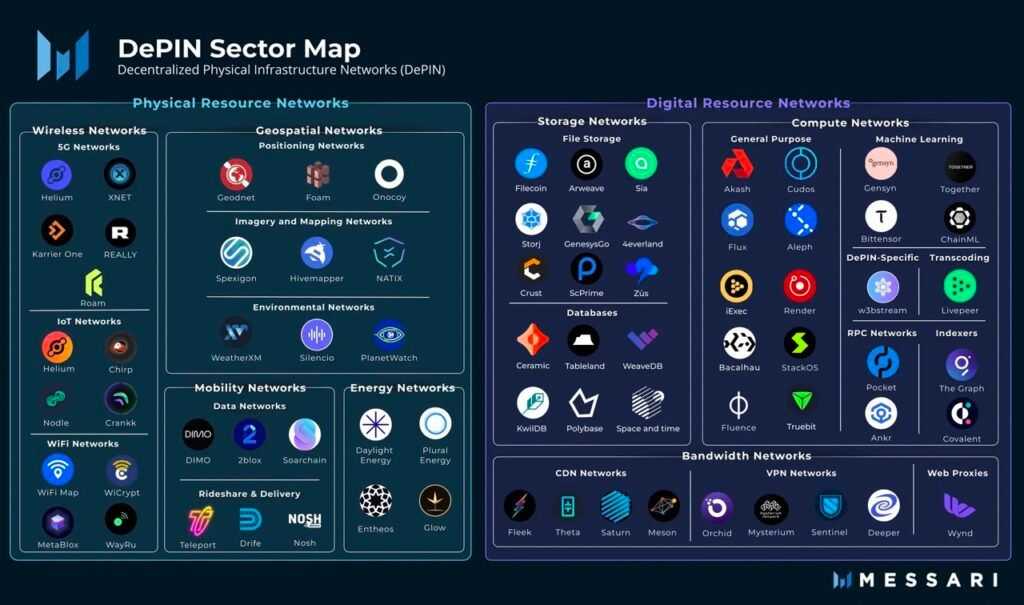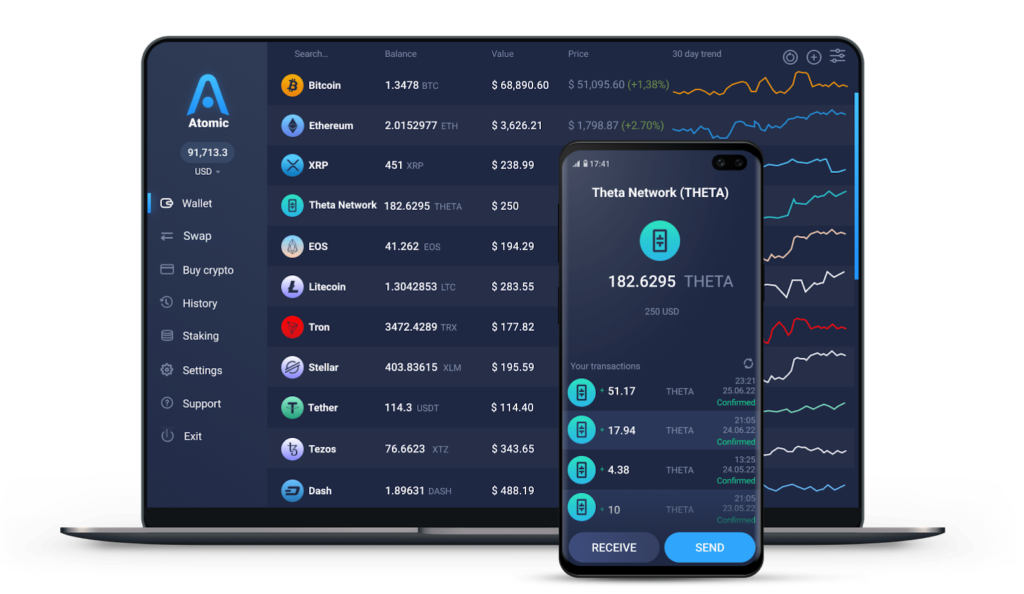Last updated on January 14th, 2025 at 05:33 pm
The recent crypto theme and current market cycle have changed the narrative of the integration of Web3 and the physical world.This has helped the growth of Tokenized Real-World Assets (RWAs) and innovation of Decentralized Physical Infrastructure Networks (DEPIN). DePin are peer-to-peer network for contribution of physical infrastructural resources to earn reward.
Blockchain is fundamental to the rise in decentralized networks and Web3. Furthermore, DEPIN has helped to decentralize and tokenize various infrastructure layers from servers and querying protocols to data collection, analysis, and storage networks.
This decentralization provides new wave of operation for infrastructural projects as a global and self-governing network. We’ll be discussing about some top DEPIN projects in 2024 for educational and informational purpose only and not intended as financial advice.
Understanding DEPIN Projects
Decentralized Physical Infastructure Network (DePIN) is a change that leverage Blockchain technology to democratize, increase efficiency and reduce control of physical infrastructural networks.
The physical infrastructure network combine all servers,computers, and wireless network that govern online data storage, usage and access control. Top cooperation like Google Cloud Computing, Microsoft Azure, Amazon web services use this network expert data.
Emergence of Decentralization
There’s a lot of factors that influence the emergence of decentralized infrastructure:
Public Pressure: there’s a growing demand for transparency and accountability in infrastructure management and has driven the adoption of systems that allow public participation and oversight.
Growth in Web3: Blockchain is an ideal blueprint for infrastructure networks because it has built a robust and sustainable computing and networking layer.
Cost Effective: there’s a huge potential in Web3 to achieve cost effective and democratize value flow using distributed networks.
The Role of Blockchain in the Emergence of DePIN Solution
Blockchain help DePIN adoption by providing various fundamental of DePIN system:
Transparency and Security: pooled security provides economic guarantee than any security layer. Distributed layer provides real-time sharing of immutable data, reducing trust and increasing accountability.
Operational Efficiency: smart contract automate data operations while eliminating dedicated compute layer.
Decentralized Governance: tokenized governance enable granular stakeholder participation in decision making to ensure consensus voting for swift, transparent, and strict communication standard.
It’s noteworthy that Blockchain is the most successful distributed network design. This further buttress it importance to DePIN solution as self-sufficient to implement DePIN solution with less hardware optimizations and smart contract programming.
DePIN Ecosystem

We’ll be using the quote of Messari’s DePIN sector map to understand various categories in this ecosystem:
It’s noteworthy that Messari divided the DePIN sector into two broad categories, namely:
Physical Resource Networks
Physical resource networks utilize decentralize methods to manage and optimize physical infrastructure in the DePIN ecosystem. It empowers Blockchain technology for efficiency, reliability, and accessibility to important services such as wireless communication, spatial data, transportation, and energy. Physical resource networks have various sub-types:
Wireless Network: it’s a decentralized network for connectivity over a distributed array of devices. A good example of this is Helium that offers peer-to-peer network of hotspot for coverage to reward operators with cryptocurrencies.
Geospatial Network: this is a decentralized collection, verification and utilization of spatial data. For instance, Hivemapper crowdsource map data through user equipped with dashcam to build and update map dynamically to demonstrate new collaborative geospatial data gathering model.
Mobility Network: it uses decentralized solutions to improve transportation and logistics system. It’s unique because it collect and analyze decentralized data to enable smart mobility solutions.
Energy Network: the energy network incorporate decentralized technology to enhance energy distribution and consumption. Plural energy utilizes Blockchain to create a decentralized energy marketplace for users to trade efficiently.
Digital Resource Networks
Digital Resource Networks uses decentralized system to manage storage,computing power, and bandwidth. It ensure security, and scalable digital service by leveraging on Blockchain technology to distribute operational load across multiple node. They’re three sub types of digital resource networks, namely:
Storage Network: it help users rent out their excess storage space on Blockchain network to ensure security across multiple locations.
Compute Network: it helps users access distributed GPU or other computing resources to run intensive application by the usage of Akash and Render networks to reduce reliance on centralized cloud providers.
Bandwidth Network: bandwidth network help users share their spare bandwidth on a peer-to-peer basis to optimize online video delivery and reducing cost.
The Graph Protocol

The Graph is a decentralized indexing protocol for organizing online data into structure and mapping it for web application or users swift retrieval. It’s the pillar behind blazing-fast internet.
Top brand like Amazon web services provides indexing services to Web2 companies around the globe. Many decentralized applications depend on centralized services for their architectural works.
Top DePIN Crypto List
Let’s dive into the top DePIN Crypto in the cryptosphere and evaluate if they’re worth investing on.
Helium Network: it’s an impressive DePIN Crypto project that has a global decentralized network of wifi hotspot of over 980,000 around the world. Users can join to become hotspot provider by placing it in their homes or offices.

It incentivize users to grow coverage network by rewarding hotspot providers with $HNT tokens. This has seen the price of $HNT jump to 230% in recent times with a Marketcap of more than $1.1 Billion.
Filecoin: filecoin is one of the largest DePIN projects with decentralized cloud storage solutions. It help users to store contents reluctantly on devices around the world to ensure they’re well backed up and censored.

InterPlanetary File System (IPFS) on filecoin helps for decentralized information storage. Users can contribute computing resources to Filecoin networks to become a storage providers and they’ll also earn $FIL token.
Theta Network: it’s a decentralized network computing resources to stream high-quality video content across the globe. Theta Network offers an in-built solution for digital right management (DRM) that enables content creators to claim royalties.

This feature has seen the rise of Theta network which now has more than 10,000 active node on it streaming network with it token been at the heart of Theta network to provide governance control on the project with a Marketcap of $2.9 Billion and is upto 70% over the past 12 months.
Conclusion
Our takeaway is that DePIN crypto looks likely to have an extremely bright future and could see explosive growth in the current crypto bull run. However, potential investors have to be very careful as this article is for informational and educational purpose only.
FAQ
Where can I buy DePin coins?
Many of the best DePIN crypto coins are available to buy on centralized exchanges like MEXC and Binance.




